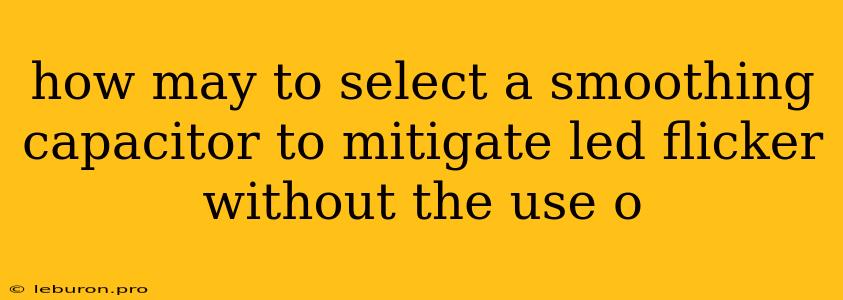Flickering LEDs can be a common problem, especially in applications where they are driven by AC power. This flickering is often caused by fluctuations in the voltage supplied to the LEDs, which can lead to an uneven and distracting light output. One way to mitigate this flickering is by using a smoothing capacitor, which acts as a temporary energy reservoir to help even out the voltage fluctuations. Choosing the right smoothing capacitor for your LED application is crucial to achieve optimal results and ensure a flicker-free experience.
Understanding LED Flickering and Smoothing Capacitors
The Root Cause: Voltage Fluctuations
LEDs are highly sensitive to voltage changes. When driven by an AC power source, the voltage fluctuates between positive and negative peaks. If the voltage is not consistently at a level suitable for the LEDs, they may dim or flicker.
How Smoothing Capacitors Help
A smoothing capacitor is an electrical component that stores energy in an electric field. When connected in parallel with the LED circuit, it acts as a voltage buffer, smoothing out the fluctuations in the voltage supplied to the LEDs.
Selecting the Right Smoothing Capacitor: A Step-by-Step Guide
1. Determine the Desired Flicker Reduction
The first step is to decide how much flicker you want to eliminate. A higher capacitance value will result in smoother voltage output and less flicker, but it also increases the cost and size of the capacitor.
2. Calculate the Required Capacitance
To determine the appropriate capacitance value for your LED application, you need to consider the following factors:
- LED Current (I_LED): The amount of current flowing through the LED.
- Voltage Drop Across the Capacitor (V_C): The difference in voltage between the peak and trough of the AC waveform.
- Desired Flicker Reduction (F_R): How much you want to reduce the flicker.
- Frequency of the AC Power (f): Typically 50 or 60 Hz.
The formula for calculating the capacitance is:
C = I_LED / (f * V_C * F_R)
3. Choose the Capacitor Type
There are several types of capacitors suitable for smoothing applications:
- Electrolytic Capacitors: These are the most common and affordable option, but they have limited voltage and temperature ratings.
- Ceramic Capacitors: These offer higher voltage and temperature ratings and better stability than electrolytic capacitors, but they are more expensive.
- Film Capacitors: These are known for their high reliability and wide operating temperature range, but they are also the most expensive option.
4. Consider the Capacitor's Voltage Rating
The voltage rating of the capacitor should be greater than the maximum voltage applied across the LED circuit. Choosing a capacitor with a lower voltage rating can lead to premature failure.
5. Account for Capacitor Size and Cost
Larger capacitance values typically require larger capacitors, which can be bulky and expensive. You need to balance the desired flicker reduction with the available space and budget.
6. Test and Adjust
After selecting a capacitor, test it in your LED application to confirm that it effectively mitigates the flicker. You may need to adjust the capacitance value or capacitor type if the results are not satisfactory.
Common Considerations
Ripple Current Rating
Capacitors have a ripple current rating, which represents the maximum amount of AC current that they can handle without overheating. It's crucial to choose a capacitor with a ripple current rating that exceeds the actual current flowing through it.
ESR (Equivalent Series Resistance)
ESR is the internal resistance of a capacitor, which affects the smoothing performance. A lower ESR value results in better smoothing and less voltage ripple.
Temperature Considerations
Capacitors have a limited operating temperature range. Ensure that the capacitor you choose can withstand the temperature fluctuations in your LED application.
Example Application
Let's say you're designing a lighting fixture with a 12V LED string that draws 100mA. The AC power frequency is 60Hz, and you want to reduce the flicker by 90%. Here's how you would choose the smoothing capacitor:
- I_LED: 100mA
- V_C: Assume a 1V ripple voltage, which is a reasonable value for smoothing applications.
- F_R: 90%
- f: 60Hz
C = (100mA) / (60Hz * 1V * 0.9) = 1850 µF
Based on this calculation, you would need a smoothing capacitor with a capacitance of at least 1850µF.
Conclusion
Selecting the right smoothing capacitor for your LED application is essential to eliminate flicker and achieve a pleasant lighting experience. By understanding the factors discussed above and following the steps in this guide, you can choose the capacitor that best meets your needs and ensure a flicker-free LED setup. Remember to test the capacitor in your application and adjust the parameters as needed to achieve optimal results.
